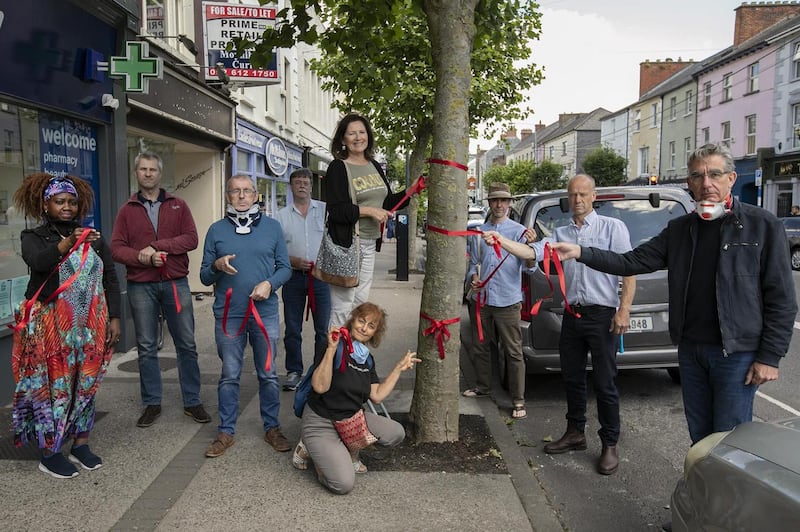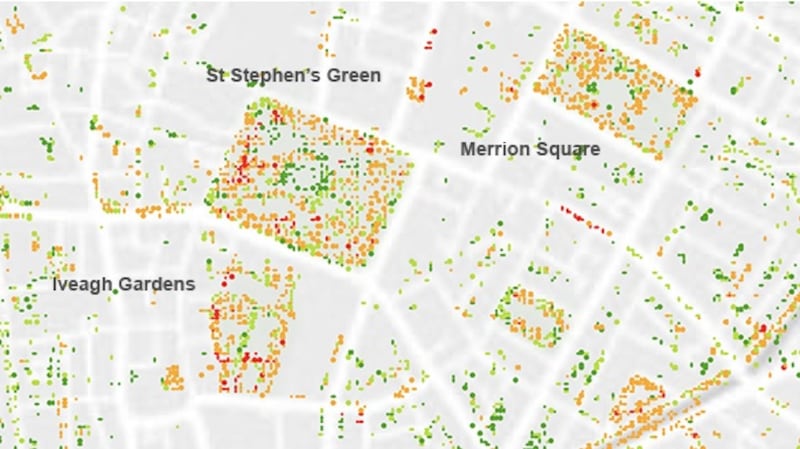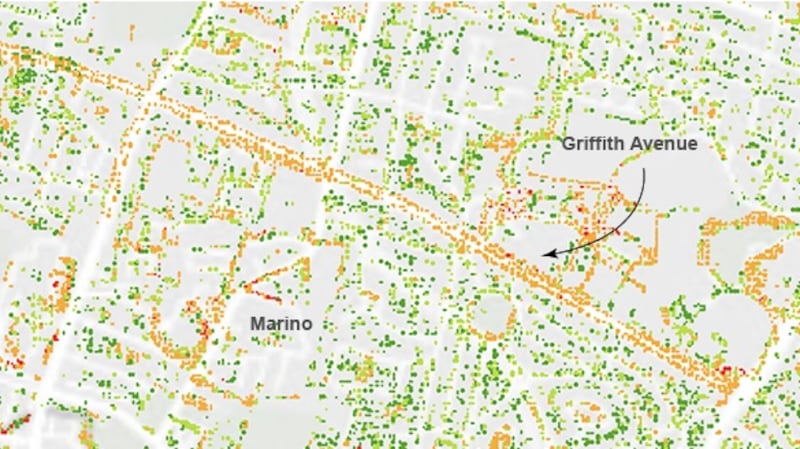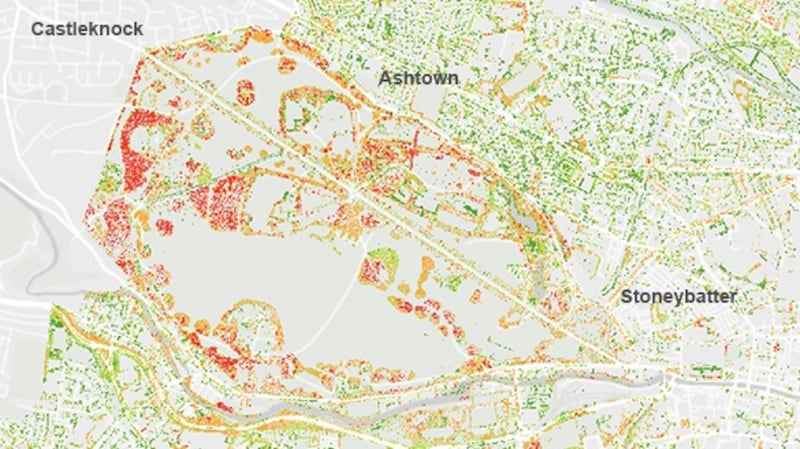"We will need to boost every imaginable carbon sink to the very maximum. A standing tree must then be worth more than a dead one," Greta Thunberg said in January 2021
There is something about majestic trees that become familiar landmarks in a locality; even more so if they are rare in a neighbourhood. Attempts to remove them cause distress, especially as living CO2-guzzling trees play an essential part in the fight against climate change.
There is evidence that local authorities are deploying a more aggressive approach to tree removal, whether it’s dictated by insurance risk associated with tree-fractured paths, damage to “underground services” or so-called urban enhancement projects.
Ireland has the fourth highest rates of asthma in the world and correspondingly the second lowest number of trees in Europe
Increasingly this has provoked anger among local citizens, as indicated by recent protests in Carrigrohane near Cork city; on the Navan Road in Dublin; and at Portaferry, Co Down, where 52,000 people signed a petition objecting to the felling of mature trees to make way for a car park at Exploris Aquarium.
Protests have centred on the scale and likely impact of work, lack of consultation, and what is regarded as poor justification when we are in the throes of climate and biodiversity emergencies.
Removal of 150 trees from the Navan Road to make way for BusConnects will damage quality of life and undermine climate change goals, local residents claimed. They tied yellow ribbons around trees lining the road, which forms the spine of the bus corridor from Blanchardstown to the city centre.
An ongoing "red ribbon protest" in Clonmel, Co Tipperary illustrates how removing trees can become contentious. There is an impasse between environmental campaigners and Tipperary County Council over the fate of some 50 mature trees located along O'Connell Street, Gladstone Street and Market Street in the heart of the town. Under a new urban design plan awaiting funding, they are due to be replaced by smaller ornamental varieties.

The case highlights, according to Alan Moore of SuirCan Environmenal group, "token public consultation by local authorities, non adherence to 'green' policy guidelines, and lack of biodiversity expertise among local authority staff".
He adds: "Tipperary Co Council say that the old trees don't fit in with the new design ... We think they should work with the existing beautiful trees and adapt their design instead."
Most of these trees are fine specimens, in good health and providing shade and character to the town centre, as well as being good for biodiversity and carbon storage, Moore says.
Clonmel based community group SuirCan Environmental argues the mature trees should have been incorporated into the plan drawn up by RPS Consulting, and that submissions from the public be taken on board. It contends that the shade, beauty, water retention, carbon sequestration and biodiversity values of the trees were overlooked "in favour of neatness and expediency".
Council engineers claim tree roots are interfering with services and laying new pavements would cause the trees to die. In June, a motion calling for an expert review of the tree issue was overruled at a council meeting. This led to SuirCan’s protest and a petition supported by almost 2,000 people. Crannach Clonmel, representing some local business owners, has also demanded a rethink.

“For us, it all comes back to our central demand that an independent arborist should be engaged to carry out a tree survey and produce a report on the suitability and viability of the trees,” Moore says.
As mature trees improve people's respiratory health, immune systems and overall wellbeing, he finds it galling that Ireland has the fourth highest rates of asthma in the world and correspondingly the second lowest number of trees in Europe.
Specialist in urban climatology based in UCD Prof Gerald Mills confirms trees "do an awful amount of work"; particularly if mature. The problem is they have not been planted strategically in urban areas, he adds, so cities and towns have ended up with relatively few of them. That also explains why their removal causes dismay.
Off his own bat, he is going to assess Clonmel’s trees “in a neutral capacity”.
With a team in UCD, Mills has mapped trees in the capital under the Mapping Green Dublin project, using near-infrared aerial imagery in the Dublin City Council area. “We estimate just over 300,000 trees, of which 19 per cent are on roads, 23 per cent are in parks, 33 per cent in private gardens and 25 per cent in other places [golf courses, institutions, schools].”

The findings confirm a typical scenario of fewer trees in city and town centres. Compounding matters, he believes, is failure to plant for specific purposes such as flood alleviation, reducing carbon and shading buildings – too much planting is simply for beautification.
As a consequence, cities and towns are now confronted by having to make hard decisions on how to increase green infrastructure while reducing traffic. The dilemma is reflected in the BusConnects issue, where it is claimed wider streets are required, many of which are “the boulevards of Dublin”.
The impact on cityscapes can be catastrophic where whole lines of trees are removed, he says, yet local authorities keep saying they will replace them. Diseased London plane and maple trees being removed on Griffith Avenue were planted before the State was formed, Mills says, which means “it will take decades to catch up.”

Instead of talking about individual trees, “we should be talking about forests in urban areas”, where harvesting and replanting are considered more, he says.
People don’t see the sequencing required to ensure tree cover, “so they get quite distressed when the obvious one is eliminated”, Mills says. He believes the pandemic has resulted in people taking much more interest in their local environment, so they are more likely to have affinity with trees and green spaces close to home.
He is not saying all hard engineering is wrong; when a root encroaches on a path, the tree probably needs to be removed. BusConnects is necessary, he accepts, but has “ridiculous” aspects on trees when climate requirements, including more cycling and walking, need to be factored in.
“Widening roads is diminishing neighbourhoods. The same areas are affected as there is only a limited number of major roads into the city,” he says, and buses still have to cross narrow bridges into the city centre. With many people likely to continue to work at home post-Covid, “the problem might not need to be solved”, Mills suggests.

Tipperary County Council defended the “Urban Realm Development” on the basis of transforming Clonmel into a sustainable, fit-for-purpose settlement over the next 50 years plus.
It said it had engaged in extensive consultation, including with people who worked or lived in the affected areas. It was necessary to widen the footpaths, to reduce traffic flows and on street parking and to upgrade underground services. This included “removal of 40 existing trees (in varying degrees of health) and replacing them with 43 semi-mature urban appropriate specimens”.
The plan was adopted by elected members and supported by the majority of citizens who contributed to the consultation process, the council underlined. It was providing trees more suitable to an urban setting, it said, and increasing the number of trees and the amount of landscaped areas. Where existing trees could be saved, they would be replanted in a local park area, the council added.
SuirCan believes token consultation is being undertaken by local authorities “and lip service being paid to official policies on biodiversity and climate change” – a view endorsed by tree campaigners elsewhere, they add.
Every effort should have been made in the Clonmel plan to entice visitors to spend time, eat, drink and linger in the town centre, SuirCan adds. “Mature trees are an important part of the attraction ... Tipperary County Council and the designers have simply got this wrong.”
Moore believes: “Local councils are now treating trees in the way a fussy homeowner decorates their home. It’s become a tree version of ‘the curtains don’t match the sofa, so out they go’.”





















